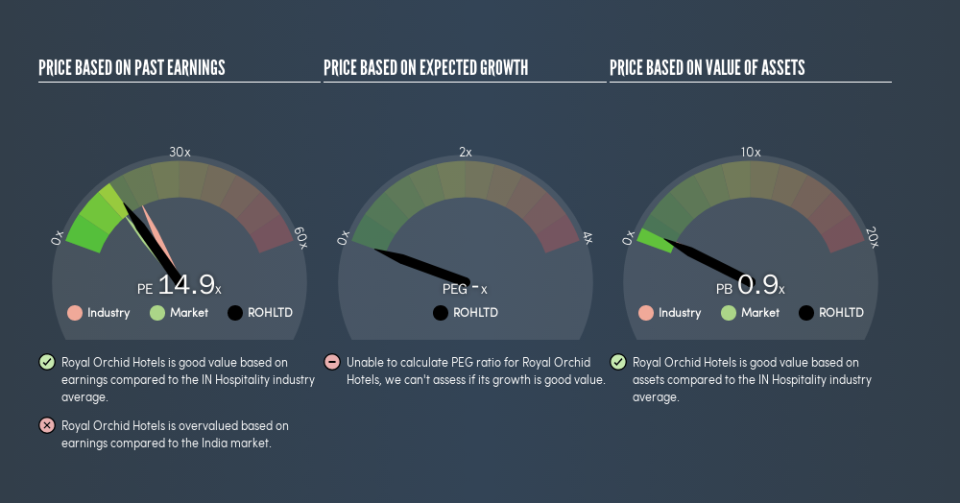Read This Before You Buy Royal Orchid Hotels Limited (NSE:ROHLTD) Because Of Its P/E Ratio

The goal of this article is to teach you how to use price to earnings ratios (P/E ratios). We'll apply a basic P/E ratio analysis to Royal Orchid Hotels Limited's (NSE:ROHLTD), to help you decide if the stock is worth further research. What is Royal Orchid Hotels's P/E ratio? Well, based on the last twelve months it is 14.91. That means that at current prices, buyers pay ₹14.91 for every ₹1 in trailing yearly profits.
See our latest analysis for Royal Orchid Hotels
How Do I Calculate A Price To Earnings Ratio?
The formula for price to earnings is:
Price to Earnings Ratio = Price per Share ÷ Earnings per Share (EPS)
Or for Royal Orchid Hotels:
P/E of 14.91 = ₹61.95 ÷ ₹4.15 (Based on the year to June 2019.)
Is A High P/E Ratio Good?
A higher P/E ratio implies that investors pay a higher price for the earning power of the business. That isn't necessarily good or bad, but a high P/E implies relatively high expectations of what a company can achieve in the future.
Does Royal Orchid Hotels Have A Relatively High Or Low P/E For Its Industry?
The P/E ratio indicates whether the market has higher or lower expectations of a company. We can see in the image below that the average P/E (18.9) for companies in the hospitality industry is higher than Royal Orchid Hotels's P/E.
Royal Orchid Hotels's P/E tells us that market participants think it will not fare as well as its peers in the same industry. Since the market seems unimpressed with Royal Orchid Hotels, it's quite possible it could surprise on the upside. If you consider the stock interesting, further research is recommended. For example, I often monitor director buying and selling.
How Growth Rates Impact P/E Ratios
Probably the most important factor in determining what P/E a company trades on is the earnings growth. If earnings are growing quickly, then the 'E' in the equation will increase faster than it would otherwise. And in that case, the P/E ratio itself will drop rather quickly. A lower P/E should indicate the stock is cheap relative to others -- and that may attract buyers.
Royal Orchid Hotels's 95% EPS improvement over the last year was like bamboo growth after rain; rapid and impressive.
Remember: P/E Ratios Don't Consider The Balance Sheet
The 'Price' in P/E reflects the market capitalization of the company. That means it doesn't take debt or cash into account. Hypothetically, a company could reduce its future P/E ratio by spending its cash (or taking on debt) to achieve higher earnings.
While growth expenditure doesn't always pay off, the point is that it is a good option to have; but one that the P/E ratio ignores.
So What Does Royal Orchid Hotels's Balance Sheet Tell Us?
Net debt is 27% of Royal Orchid Hotels's market cap. You'd want to be aware of this fact, but it doesn't bother us.
The Bottom Line On Royal Orchid Hotels's P/E Ratio
Royal Orchid Hotels's P/E is 14.9 which is above average (13.1) in its market. The company is not overly constrained by its modest debt levels, and its recent EPS growth is nothing short of stand-out. So to be frank we are not surprised it has a high P/E ratio.
Investors should be looking to buy stocks that the market is wrong about. If the reality for a company is better than it expects, you can make money by buying and holding for the long term. So this free report on the analyst consensus forecasts could help you make a master move on this stock.
Of course, you might find a fantastic investment by looking at a few good candidates. So take a peek at this free list of companies with modest (or no) debt, trading on a P/E below 20.
We aim to bring you long-term focused research analysis driven by fundamental data. Note that our analysis may not factor in the latest price-sensitive company announcements or qualitative material.
If you spot an error that warrants correction, please contact the editor at editorial-team@simplywallst.com. This article by Simply Wall St is general in nature. It does not constitute a recommendation to buy or sell any stock, and does not take account of your objectives, or your financial situation. Simply Wall St has no position in the stocks mentioned. Thank you for reading.

